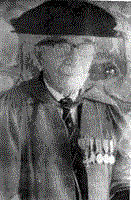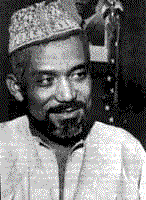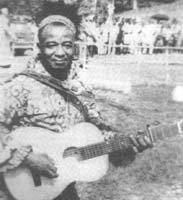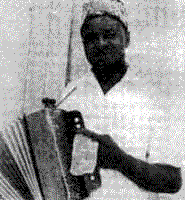McCORMACK
CHARLES FARRELL EASMON M.C.F. Easmon was a medical
doctor who fought against racial discrimination in the Sierra Leone
medical service for many years. He McCormack Charles Farrell Easmon was born in Accra in the Gold Coast (Ghana) where his father, a prominent Krio doctor, was working at the time. He was educated at the CMS Grammar School in Freetown and later at St. Paul's Preparatory School in London. He attended Epsom College in Surrey and, after graduating in 1907, was awarded scholarships to study medicine at the Medical School of St. Mary's Hospital in London. He qualified in medicine and surgery in 1912, and the following year passed the examination of the London School of Tropical Medicine. When Dr. Easmon returned to Sierra Leone in 1913, he was refused a post in the West African Medical Service because of his colour. There were then two categories of doctors —Europeans in the "colonial service" and Africans in the "local service." Dr. Easmon, forced into the separate and lower category despite his excellent qualifications, became Country Hospital Native Medical Officer. But he campaigned for years against racial discrimination in the medical service, earning the antipathy of the British authorities who called him the "Yellow Peril." During World War I, Dr. Easmon enlisted in the army and served as a medical officer in the Cameroons. After the war, he returned to England for further study and, in 1925, was awarded a medical qualification in obstetrics and gynaecology. For the next twenty years, M.C.F. Easmon served in a variety of medical posts in the protectorate, where he acquired a profound interest in the customs and traditions of the upcountry peoples. He published a series of scholarly articles on Madam Yoko, various paramount chiefs, the famous Massaquoi Crown, and Sierra Leone's distinctive country cloth. He also became an accomplished amateur historian, publishing several well-researched articles on the early history of the Freetown colony. Dr. Easmon retired from the medical service in 1945, and had the satisfaction of seeing the British finally unify the two separate medical services the following year. But at the age of fifty-five, Dr. Easmon embarked on an entirely new career. He served part-time on various government boards and was at one point a director of the Bank of Sierra Leone, but his principal interest was the preservation of Sierra Leone's historical and cultural heritage. In 1947, he became the first chairman of the Monuments and Relics Commission, and presided over the official declaration of twenty national historic sites. As a member of the Sierra Leone Society, he spearheaded the founding of the Sierra Leone Museum in 1958 and became its first curator, working untiringly to acquire worthy exhibits for the museum and to set up attractive displays. He also worked hard to acquaint the public with Sierra Leone's history and culture, hosting a popular radio programme called "Sierra Leone in Retrospect." In 1954, Dr. Easmon was awarded the Order of the British Empire (O.B.E.). Dr. M.C.F. Easmon fell ill while on holiday in England in 1969 and never returned to Sierra Leone. He had won his battle against racial discrimination in the medical service, but his work to preserve Sierra Leone's historical and cultural heritage had only just begun. Dr. Easmon was a pioneer in the field of cultural nationalism. He leaves behind an example well worth following. |
JOHN AKAR John Joseph Akar was born in
1927 at Rotifunk, Bumpe Chiefdom in what is today Moyamba District,
where he attended the E.U.B. In 1960, he was appointed the first indigenous Director of Broadcasting, and during his tenure he brought creative programme leadership to the Sierra Leone Broadcasting Service. Through him, Sierra Leone broadcasting was raised to the highest professional standards that became the envy of the region. His aim was to get the Sierra Leone Broadcasting Service to reflect more and more the true image of the country, its music, its songs and its talent. His influence was clearly distinctive in these area—he was the writer of the music of the Sierra Leone National Anthem. He founded the National Dance Troupe and used it as a vehicle to encourage Sierra Leoneans to be proud of their rich cultural heritage. He led the troupe on many successful performances around the world. After the troupe's participation in the 1964 New York World's Fair, the following report was made: "This talented folk dance troupe imposed a vivid image of Sierra Leone on the minds of thousands of Americans when it took the New York World's Fair by storm in 1964." In fact, it was voted the best dance ensemble at the fair, and was presented with a gold plaque. In 1965, the troupe performed at the Commonwealth Arts Festival in London, where it had a great success. The following year, the troupe performed at the Festival of Negro Arts in Dakar, after which they did a four month tour of Western Europe. The pioneering role played by John Akar awakened cultural consciousness among rural as well as urban populations, and firmly established Sierra Leone's place on the world cultural map. The immense potentialities of our indigenous cultures to rouse the people to action, cement national unity, and to open out to the wonderful realities of our times lay dormant, and if there is one things that John Akar achieved for his countrymen, it was to instill in them a sense of pride, a love for country and an awareness of their rich cultural heritage. |
EBENEZER
CALENDAR Ebenezer Calendar was a
cultural musician, historian and social commentator who used his popular
maringa music to entertain and He was born in Freetown on November 19, 1912 of a Jamaican father and a Sierra Leonean mother. Calendar had an interrupted primary school career, attending Bishop Edwin Tabernacle and U.B.C. primary schools. According to some sources, this was the result of the hard times which the family experienced after the death of Calendar's father. Calendar left school at the age of fifteen because his mother could not afford to pay his way through secondary school. Other sources, however, suggest that Calendar dropped out of school of his own free will, influenced largely by his young friends. He joined the Public Works Department (P.W.D.) in 1927 as an apprentice carpenter. By 1930, he had become a qualified carpenter, and he was employed by Pa Alimamy Boungie, an undertaker at Kissy Street. Pa Boungie's undertaker shop used to conduct wake-keeping ceremonies for bereaved families. Thus Calendar would learn coffin-making during the day, and at night he would be among the men Pa Boungie would send to sing at wake-keeping ceremonies. About this time, Calendar and two of his friends formed a small musical group. They practiced on open grounds, and on-lookers would sometimes give them money. Later, they began getting invitations to perform at weddings, parties and other festive occasions. All this was just part-time, reserved for evenings, as Calendar continued working for Pa Boungie. Before finally embarking on a full-time musical career, Calendar worked for some time with the Sierra Leone Railway, opened and ran an undertaker shop, and then was employed as cabinet-maker for the United African Company Limited (U.A.C.). A versatile musician, Calendar learnt to play several different musical instruments, including the mandolin, the cornet, rhythm guitar and the trumpet. Calendar's group in the 1940s and 1950s relied upon a combination of locally-produced instruments like the bata (hand drum) and the triangle, and Western instruments like the guitar and the tambourine to produce his distinctive maringa rhythm. In 1951, he was commissioned by DECCA Recording Company to record a song commemorating the launching of the newly-introduced double-decker buses. The tune was an instant success, and Calendar established his reputation as a popular songwriter/musician celebrating contemporary events of the period. From this point of view, he can be looked upon as a social historian, commenting on contemporary happenings. Calendar's early songs formed part of the dance music of the fifties and sixties, and most of his compatriots will remember the swinging rhythm of the hit song "Fire, Fire." As he grew older, his music became more philosophical, and he began to consider himself more as a teacher with the responsibility of imparting the lessons he gained from life to a younger generation. Wrapped in delightful music, Calendar preached the morality of a Krio-Christian society, with the rhythm making it easy for the people to identify with him and the values he advocated. Ebenezer Calendar also helped popularise the radio when he joined the Sierra Leone Broadcasting Service in 1952 as a programme officer. He performed with the Sierra Leone National Dance Troup at the Commonwealth Arts Festival in 1965 and 1966. On April 19, 1983 he was awarded the Certificate of Honour by the President of Sierra Leone for his meritorious service in the field of indigenous music. When he died in 1985, music groups from all over Freetown converged on his home at the foot of Mt. Aureol and played his songs continuously for twenty-four hours. Thousands gathered to remember the man they all loved and admired. Ebenezer Calendar's place in Sierra Leone's history is assured because of his significant contribution to the development of a distinctively Sierra Leonean musical tradition. |
SALIA KOROMA Salia Koroma was born in
Segbwema although his parents had come from Kpa-Mende country. As a
young man, Salia's father left Salia was bitterly disappointed at first, but on the insistence of his father he settled down to playing the accordion "to the warriors and not for Europeans." From then on, Salia took his "education" seriously. Through hard work, determination and an innate poetic talent, he taught himself to play the accordion. Although his father was a renowned accordionist himself, Salia learnt by his own experience. He spoilt many accordions in the process but his father always bought him a new one. Gradually, Salia's reputation began to spread, first in Mendeland and later all over Sierra Leone. He travelled from place to place entertaining chiefs and people with his stories and songs. After serving several chiefs, he moved to Rotifunk where he was court entertainer to Chief Albert Caulker for some time. After his stay in Rotifunk, he moved to Moyamba to work for the famous Chief Julius Gulama. Always searching for knowledge and true to the spirit of minstrels, Salia was constantly on the move. He eventually ended up in Freetown where he joined the Sierra Leone Police Force until the outbreak of the Second World War. Up to this day, Salia remembers distinctly that his number in the police force was 377. His police duties did not stop him from playing the accordion. Salia has composed hundreds of songs and entertained people in all walks of life all over the country. He has been a symbol of the artist in our traditional society, and he has spent all his life trying to establish the fact that there is dignity in art — especially indigenous art. He is disappointed that Sierra Leone does not give enough appreciation to the efforts of indigenous artists. But he remains optimistic, and believes that even in his old age, he can still contribute to his art and to the nation's cultural development. |

 was also the founder and first
curator of the Sierra Leone Museum.
was also the founder and first
curator of the Sierra Leone Museum. school. Subsequently he went on to the
Albert Academy before proceeding to the United States and Britain to
continue his studies. During his sojourn abroad, he distinguished
himself as a good scholar and a versatile communicator and entertainer.
He studied commercial radio and television in America, Britain, France
and the West Indies, and appeared on television and in films.
school. Subsequently he went on to the
Albert Academy before proceeding to the United States and Britain to
continue his studies. During his sojourn abroad, he distinguished
himself as a good scholar and a versatile communicator and entertainer.
He studied commercial radio and television in America, Britain, France
and the West Indies, and appeared on television and in films. educate his fellow countrymen.
educate his fellow countrymen. him in the care of his mother while he
went to seek his fortune elsewhere. Salia was anxious to go to school
but his uncles, who were responsible for him in the absence of his
father, did not feel disposed to send him to school. Rather, they sent
their own children. The young Salia therefore went in search of his
father whom he finally found at Boajibu in the Sembaru Chiefdom. He
expressed his desire for education and his father promised that he would
indeed "send him to school." He then proceeded to give young
Salia an accordion and said, "This is your school."
him in the care of his mother while he
went to seek his fortune elsewhere. Salia was anxious to go to school
but his uncles, who were responsible for him in the absence of his
father, did not feel disposed to send him to school. Rather, they sent
their own children. The young Salia therefore went in search of his
father whom he finally found at Boajibu in the Sembaru Chiefdom. He
expressed his desire for education and his father promised that he would
indeed "send him to school." He then proceeded to give young
Salia an accordion and said, "This is your school."